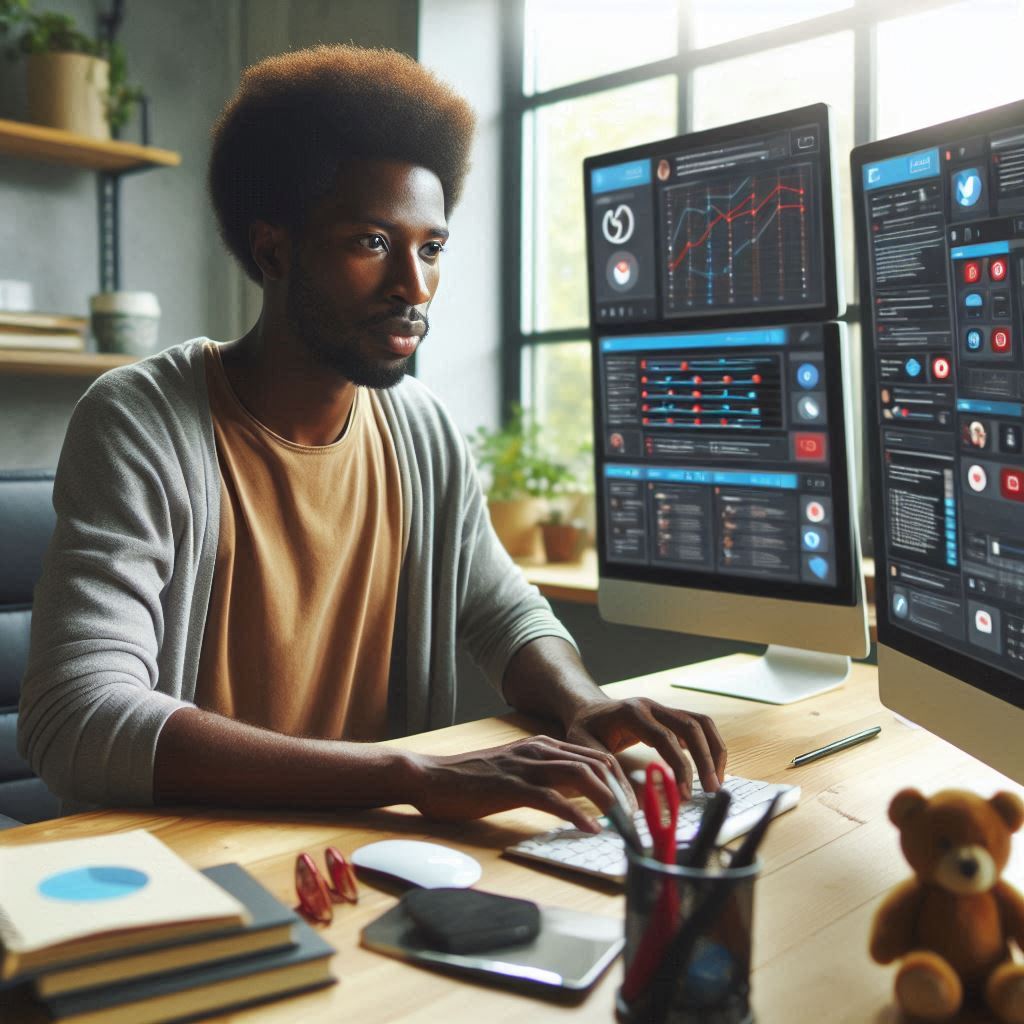Introduction
The rise of social media and influencer marketing
Social media has transformed communication, creating new opportunities for brands.
Influencer marketing emerges as a vital strategy within this dynamic landscape.
Brands seek to connect with audiences authentically through voices that resonate.
Influencers bridge the gap between companies and consumers, enhancing brand trust and loyalty.
As influencer marketing grows, so do the challenges associated with managing campaigns effectively.
Brands face increasing pressure to deliver engaging content consistently.
This is where social media automation tools come into play.
These tools streamline the management of influencer campaigns, saving time and resources.
Overview of social media automation tools
Social media automation tools simplify various tasks, such as content scheduling and performance tracking.
They allow brands to plan their posts in advance, ensuring a steady stream of content.
Brands can maintain an active online presence without constant manual input.
Moreover, these tools provide valuable analytics that reveal what works and what doesn’t.
Importance of the topic in the contemporary digital marketing landscape
Measurement is crucial in digital marketing.
Automation tools offer insights into engagement rates, reach, and conversions.
Brands can analyze these metrics to refine their strategies.
Continuous improvement leads to more effective influencer collaborations, resulting in higher return on investment.
Additionally, these tools enhance communication between brands and influencers.
They facilitate seamless collaboration by organizing tasks and deadlines.
This fosters a more efficient workflow, improving overall campaign effectiveness.
Influencers can focus on crafting authentic content rather than administrative tasks.
Moreover, automation tools help brands discover new influencers aligned with their values.
They provide databases filled with potential partners, enabling targeted outreach.
Brands can select influencers based on audience demographics, engagement metrics, and niche relevance.
The contemporary digital marketing landscape demands innovative solutions.
Social media automation tools not only save time but also drive effective influencer campaigns.
As brands navigate this ever-changing environment, leveraging automation will remain essential for success.
Understanding Social Media Automation Tools
Definition and Purpose of Social Media Automation Tools
Social media automation tools streamline the management of social media platforms.
These tools help brands and marketers automate routine tasks.
They allow users to schedule posts, analyze performance, and boost engagement.
Their primary purpose is to save time and enhance efficiency in marketing strategies.
Automation tools facilitate consistency in content delivery.
They also enhance the overall effectiveness of influencer campaigns.
By using these tools, brands can optimize their social media presence.
They enable precise tracking and measurement of campaign success.
Additionally, these tools provide valuable insights for future campaigns.
We Design & Develop Websites, Android & iOS Apps
Looking to transform your digital presence? We specialize in creating stunning websites and powerful mobile apps for Android and iOS. Let us bring your vision to life with innovative, tailored solutions!
Get Started TodayTypes of Automation Tools Commonly Used
Several types of automation tools play critical roles in social media marketing.
These tools focus on various aspects of campaign management:
- Scheduling Tools: Scheduling tools allow users to plan and publish social media posts in advance.
Popular tools, like Hootsuite and Buffer, help organizations maintain a consistent posting schedule.
They allow for better time management, especially for busy marketers. - Analytics Platforms: Analytics platforms track performance metrics across social media channels.
These platforms provide insights on engagement, reach, and conversion rates.
Tools like Google Analytics and Sprout Social help marketers measure the success of their influencer campaigns. - Engagement Boosters: Engagement boosters enhance interactions with audiences. These tools prompt timely responses to comments and messages.
They can also encourage audience participation through polls and contests. - Content Curation Tools: Content curation tools help brands gather relevant content from various sources.
These tools ensure that brands share valuable information, thereby enhancing authority.
Examples include Feedly and Pocket, which collect articles and media related to specific industry topics. - Listening Tools: Listening tools monitor social conversations around brands and competitors.
They enable brands to capture audience sentiment and respond accordingly.
Tools like Brandwatch and Mention provide valuable insights into brand perception.
Benefits of Automation in Routine Tasks and Campaign Management
Using social media automation tools provides numerous benefits, boosting marketing efficiency.
Key advantages include:
- Time Savings: Automation reduces time spent on routine tasks, enabling focus on strategy and creativity. Scheduled posts free up hours for planning.
- Increased Consistency: Automated posts ensure a steady online presence, keeping audiences engaged, even during busy periods.
- Enhanced Analytics: Automation tools offer detailed insights into audience behavior, helping brands refine targeting and improve campaigns.
- Improved Audience Engagement: Quick, automated responses enhance customer satisfaction, while prompts encourage user-generated content and community building.
- Scalability: Automation supports campaign growth by managing content demands, keeping brands competitive in crowded markets.
- Data-Driven Decision Making: Automation tools collect and analyze data, enabling brands to make informed decisions and optimize strategies.
These tools do more than schedule posts; they improve influencer marketing strategies:
- Influencer Identification: Automation tools analyze engagement data, helping brands find influencers aligned with their audience.
- Audience Targeting: Collected insights ensure brands reach the right demographics, increasing campaign effectiveness.
Automation tools streamline relationship-building with influencers, enhancing engagement and collaboration.
Incorporating social media automation has become essential in modern marketing.
These tools help marketers manage campaigns, allowing them to focus on creativity and strategic planning.
The diverse functionalities of automation maximize impact, improving efficiency, scalability, and data insights.
As social media evolves, automation tools will continue to shape successful influencer campaigns, keeping brands at the forefront of digital marketing.
Read: Harnessing Social Media Data for Advanced AI-Driven Consumer Insights
How Automation Tools Enhance Influencer Discovery
In the rapidly evolving world of digital marketing, finding the right influencers has never been more critical.
Automation tools transform how brands discover influencers.
These tools streamline the discovery process, allowing brands to focus on building relationships rather than sorting through endless profiles.
Exploration of Tools that Aid in Identifying the Right Influencers
Many automation tools specialize in influencer discovery.
Each tool offers unique features that help brands connect with the right individuals.
Some of the most popular influencer discovery tools include:
- BuzzSumo: This tool identifies influencers based on topic authority and engagement metrics.
- Upfluence: It provides a comprehensive influencer database, allowing users to filter by various criteria.
- Influencity: This platform utilizes advanced algorithms to assess influencer authenticity and engagement.
- Traackr: Known for its extensive database, Traackr helps brands build influencer relationships.
- Klear: Provides in-depth analytics on influencers, including their audience demographics and engagement rates.
These tools offer valuable insights.
They highlight not just the reach of influencers but also their engagement quality.
Brands can analyze influencer performance based on multiple metrics, allowing for informed decisions.
Algorithms and Metrics Used to Evaluate Influencer Effectiveness
Automation tools employ various algorithms and metrics to evaluate influencer effectiveness.
Understanding these metrics is essential for brands wishing to collaborate effectively.
Key performance indicators include:
- Engagement Rate: The ratio of interactions (likes, comments, shares) per follower. This metric indicates how well an influencer’s audience responds to their content.
- Follower Growth Rate: The speed at which an influencer’s follower count increases. A consistent growth rate signals influencer appeal and relevance.
- Authenticity Score: This measures the percentage of an influencer’s followers that are genuine. High authenticity indicates a more engaged, real audience.
- Content Relevance: Analyzing the themes and topics an influencer covers, ensuring alignment with brand messaging.
- Brand Affinity: This assesses how well an influencer’s previous collaborations align with a brand’s image. Strong brand affinity suggests a better fit for future campaigns.
Algorithms within these tools analyze vast amounts of social media data.
They offer brands tailored lists of potential influencers whose audience matches target demographics.
By leveraging these metrics, brands can make strategic decisions on influencer selections.
Case Study: A Successful Influencer Campaign Utilizing Discovery Tools
Consider the case of a well-known beauty brand that successfully utilized automation tools for an influencer campaign.
This brand aimed to launch a new skincare line.
They faced challenges cutting through market noise and achieving visibility.
Thus, they opted for an influencer marketing strategy.
Here’s how they did it:
Step 1: Tool Selection
The brand began by selecting Upfluence for influencer discovery.
They wanted data-driven insights for effective influencer identification.
Step 2: Defining Goals and Metrics
The brand clearly defined goals such as increased product awareness and engagement metrics.
They decided to focus on influencers within the beauty, skincare, and lifestyle niches.
We Design & Develop Websites, Android & iOS Apps
Looking to transform your digital presence? We specialize in creating stunning websites and powerful mobile apps for Android and iOS. Let us bring your vision to life with innovative, tailored solutions!
Get Started TodayStep 3: Discovering Influencers
Using Upfluence, the brand filtered influencers by engagement rate, audience demographics, and content relevance.
This approach resulted in a shortlist of high-potential influencers.
Step 4: Analyzing Influencer Metrics
The team evaluated the shortlisted influencers using performance metrics.
They prioritized those with high authenticity scores and engagement rates.
This selection process ensured that chosen influencers could genuinely connect with their audiences.
Step 5: Building Relationships
The brand then reached out to selected influencers for collaboration.
They fostered relationships through personalized messages highlighting mutual interests and campaign goals.
Step 6: Campaign Execution
During the campaign, influencers created authentic content showcasing the new skincare line.
They shared unboxing videos, tutorials, and personal testimonials.
This generated buzz and encouraged audience engagement.
Step 7: Measuring Success
After the campaign, the brand assessed its success through engagement metrics and sales data.
The campaign achieved a 30% increase in product sales and an impressive engagement rate of 10%.
The beauty brand effectively harnessed the power of automation tools.
Automation tools fundamentally enhance influencer discovery.
These tools simplify the search for the right influencers, providing brands with invaluable insights.
By leveraging algorithms and metrics, brands can make informed choices.
Moreover, successful case studies illustrate their effectiveness in real-world applications.
As brands continue to invest in influencer marketing, the role of automation tools will only grow.
They empower brands to discover influencers who genuinely resonate with their audiences.
Automating the discovery process saves time and enhances strategic collaborations.
Read: The Impact of Deep Learning on Social Media User Behavior Prediction
Streamlining Content Creation and Distribution
In the fast-paced world of social media, brands need effective strategies to captivate audiences.
Influencer campaigns require precise coordination, compelling content, and timely distribution.
Automation tools have transformed content creation and distribution, making it easier for brands to succeed.
Below, we will explore various methods for automating content creation, the benefits of scheduling posts for optimal engagement, and examples of brands that have leveraged these strategies successfully.
Methods for Automating Content Creation
Automating content creation offers numerous advantages for influencers and brands.
Here are some effective methods:
- Templates: Using templates can significantly reduce the time spent on content creation.
Brands can create pre-designed social media posts, allowing influencers to customize text and images easily.
This approach lends a consistent visual identity, ensures brand alignment, and saves resources. - AI-Generated Content: Advances in artificial intelligence enable brands to generate content quickly.
AI tools can create captions, blog posts, and even visual content based on specific brand guidelines.
This automation allows influencers to focus on strategy rather than spending hours crafting every post. - Content Curation Tools: These tools automate the process of finding relevant articles, images, and videos that align with a brand’s voice.
By using content curation tools, influencers can share relevant material without sourcing everything manually. - Graphic Design Automation: Platforms like Canva offer design templates and automation features for creating eye-catching graphics.
Influencers can generate professional-quality visuals quickly without needing advanced design skills. - Video Editing Automation: Tools like Lumen5 allow influencers to transform blog posts into engaging videos.
Automating video creation can boost engagement, as video content often garners higher audience interaction.
Scheduling Posts for Optimal Engagement Through Automation
Effective timing can significantly enhance engagement rates on social media.
Scheduling tools allow brands and influencers to plan their content in advance.
Here are the benefits:
- Optimal Posting Times: Automation tools analyze audience behavior, suggesting the best times to post for maximum engagement.
Brands can schedule posts to align with their audience’s online activity, ensuring that content reaches followers when they are most active. - Consistent Posting: Posting consistently builds audience trust and loyalty. Automation ensures regular posts without the need for constant manual input.
By maintaining a constant presence, brands remain top-of-mind for their audiences. - Efficiency: Scheduling tools save time by allowing brands to upload multiple posts in one sitting.
This efficiency frees up time for influencers to focus on strategy, engagement, and collaboration with brands. - Coordinated Campaigns: Automation aids in planning cohesive campaigns across multiple platforms.
Brands can schedule posts according to a specific timeline, ensuring all influencers share content simultaneously for maximum impact. - Real-Time Adaptability: Many scheduling tools allow for real-time changes, enabling brands to adapt their strategies based on current trends or events.
This responsiveness enhances a brand’s relevance in a constantly evolving social media landscape.
Examples of Brands That Successfully Leverage Automated Content Distribution
Many brands have successfully integrated automation tools into their influencer campaigns.
Here are a few notable examples:
- Buffer: Buffer utilizes its own automation tools effectively. The brand schedules posts across multiple platforms to maintain a consistent online presence.
Buffer’s content strategy focuses on quality engagement, maximizing reach through automated scheduling. - Hootsuite: Hootsuite helps influencers and brands schedule and monitor their social media posts. It aggregates analytics and provides insights into engagement metrics.
By using Hootsuite, brands like *Red Bull* seamlessly manage large-scale campaigns across various channels. - Sprout Social: This platform offers advanced automation features for scheduling and reporting. Brands can analyze audience engagement and adjust content in real-time.
Companies like *Disney* use Sprout Social to manage their vast social media presence effectively. - CoSchedule: CoSchedule combines marketing and social media management functions. Brands like *HubSpot* utilize it to streamline their campaigns.
With content planning, scheduling, and tracking all in one interface, efficiency skyrockets for HubSpot’s marketing team. - Later: Focused primarily on visual platforms like Instagram, Later automates posting and analytics.
Influencers and brands, such as *Nike*, utilize Later to schedule stunning posts that highlight products effectively and on-trend.
In summary, automation tools for content creation and distribution significantly enhance influencer campaigns.
These tools streamline the creative process, allowing for consistent, optimized content across platforms.
Influencers can focus more on engagement and relationship-building, while brands can promote a cohesive message.
We Design & Develop Websites, Android & iOS Apps
Looking to transform your digital presence? We specialize in creating stunning websites and powerful mobile apps for Android and iOS. Let us bring your vision to life with innovative, tailored solutions!
Get Started TodayBy adopting these strategies, brands can establish a strong online presence, build meaningful relationships, and increase their return on investment in influencer marketing.
The future of influencer campaigns will continue to evolve, but automation is undoubtedly a critical component of that evolution.
Read: How AI-Powered Video Editing Software is Transforming Social Media Content Creation

Monitoring and Analytics: The Power of Data
In the realm of influencer marketing, data is a crucial asset.
Automation tools enhance campaigns by providing accurate monitoring and robust analytics.
By harnessing the power of automation, brands can track campaign performance and adjust strategies accordingly.
Understanding campaign effectiveness is pivotal for maximizing return on investment (ROI).
The Role of Automation in Tracking Campaign Performance
Automation tools streamline the process of tracking influencer campaigns.
They eliminate manual efforts, saving time and reducing errors.
Brands can analyze multiple data points effortlessly.
Real-time data collection allows marketers to respond promptly to shifts in audience engagement.
This speed makes campaigns more agile and responsive.
Automation tools can manage various marketing channels simultaneously.
Influencers often operate across multiple platforms like Instagram, YouTube, and TikTok.
Automation helps consolidate data from these channels into one unified dashboard.
This integration provides a comprehensive view of campaign performance.
As a result, brands can assess which platform generates the best engagement.
Key Performance Indicators (KPIs) to Monitor
Identifying the right KPIs is essential for gauging influencer campaign success.
Here are several critical KPIs businesses should monitor:
- Engagement Rate: This measures likes, comments, shares, and overall interactions.
- Reach: This indicates how many unique users have seen the campaign.
- Impressions: This counts the total number of times the content was displayed.
- Follower Growth: This tracks how many new followers are gained during the campaign.
- Conversion Rate: This measures the percentage of users who completed a desired action, like making a purchase.
- Cost Per Engagement (CPE): This calculates the cost-effectiveness of the campaign based on engagement levels.
By measuring these KPIs, brands gain insights into influencer performance.
This understanding allows for data-driven decisions that enhance future campaigns.
Additionally, setting benchmarks against these KPIs enables companies to evaluate campaign success accurately.
Tools Offering Real-Time Analytics and Insights
Several automation tools provide essential analytics and insights for influencer campaigns.
Below is a selection of notable tools that marketers find invaluable:
- Hootsuite: This tool allows marketers to monitor multiple social networks in one platform. It provides comprehensive analytics on engagement and reach.
- Sprout Social: Sprout Social offers in-depth reporting features that help brands understand audience interactions.
Its sentiment analysis enhances campaign strategies by revealing audience perceptions. - Buzzsumo: Buzzsumo excels at identifying trending content and influential bloggers. It offers insights on engagement metrics for different pieces of content.
- Google Analytics: While not exclusive to influencer campaigns, Google Analytics helps track conversion rates related to influencer marketing. It enables tracking of referral traffic generated by influencer posts.
- Upfluence: This tool specializes in influencer marketing. It provides real-time metrics about influencer reach, engagement rates, and audience demographics.
These powerful tools equip marketers with the insights necessary to optimize their campaigns.
They also afford businesses the ability to refine their strategies based on live data.
Harnessing Data for Improved Decision-Making
Data-driven decision-making significantly enhances influencer marketing effectiveness.
Brands increasingly rely on analytics to refine their strategies.
Real-time feedback reveals what resonates with the audience.
Consequently, businesses adjust their campaigns for better engagement.
By embracing automation, marketers can conduct A/B testing swiftly.
This method allows testing different creative elements to see what works.
For instance, they can experiment with different calls to action or types of content.
Results from these tests provide valuable insights into audience preferences.
Responding to Trends and Shifts
Social media platforms evolve rapidly. Trends change quickly, and audience interests shift.
We Design & Develop Websites, Android & iOS Apps
Looking to transform your digital presence? We specialize in creating stunning websites and powerful mobile apps for Android and iOS. Let us bring your vision to life with innovative, tailored solutions!
Get Started TodayAutomation tools help marketers stay ahead of these trends.
With real-time analytics, brands notice changes in audience sentiment and behavior.
This immediate insight allows for timely adjustments to content or strategy.
For instance, if an influencer’s campaign shows declining engagement, brands can pivot their messaging.
Instead of waiting for a post-campaign analysis, they can make real-time changes.
This adaptability keeps campaigns relevant and engaging.
Effective monitoring and analytics form the backbone of successful influencer campaigns.
Automation tools allow brands to harness data efficiently, improving campaign performance.
By tracking KPIs and utilizing real-time analytics, companies gain timely insights.
Choosing the right tools significantly impacts the effectiveness of influencer marketing strategies.
Understanding data helps brands make informed decisions that drive engagement.
Ultimately, leveraging the power of data through automation can lead to more successful influencer marketing campaigns.
Read: Cloud-Based Social Media Management Tools: The Next Frontier for Businesses
Enhancing Engagement Through Automation
Social media has become a cornerstone for marketing strategies, especially influencer campaigns.
Brands leverage influencers to expand their reach and connect with target audiences.
Automation tools can enhance these campaigns, driving engagement and streamlining processes.
This section explores how engagement strategies through automation can elevate influencer marketing.
Strategies for Automating Engagement with Audience and Influencers
To foster meaningful connections with audiences and influencers, brands utilize various automation strategies.
These strategies enable marketers to maintain continuous engagement and optimize campaign performance.
Here are some effective methods:
- Scheduled Posts: Use automation tools to schedule posts at times when audiences are most active. This ensures maximum visibility and interaction.
- Content Curation: Automatically select and share relevant content based on trending topics or audience interests. This positions your brand as an authority in your niche.
- Social Listening: Employ tools that monitor brand mentions, hashtags, and keywords. This helps identify opportunities to engage with both followers and influencers.
- Performance Analytics: Use analytics to evaluate engagement metrics. Automated reports can reveal what content works best with the audience.
These strategies help brands maintain a consistent presence while responding to follower interests swiftly.
Automation allows marketers to focus more on creative aspects while ensuring effective audience engagement.
Utilizing Chatbots and Automated Replies for Immediate Interaction
Chatbots have revolutionized customer service and engagement strategies.
They provide instant responses, enhancing user experience.
When integrated into social media campaigns, chatbots offer numerous advantages:
- 24/7 Availability: Chatbots operate around the clock. This ensures that audience questions receive prompt responses, regardless of time.
- Handling FAQs: Chatbots can manage frequently asked questions, freeing up human resources for more complex inquiries. This saves time for brands and users alike.
- Personalized Interactions: Advanced chatbots can deliver personalized experiences by using data from previous interactions. They create a tailored engagement approach.
- Lead Generation: Chatbots can qualify leads through interactive conversations. They gather essential information to help brands understand audience needs better.
Integrating chatbots into influencer campaigns maximizes engagement efficiently.
They maintain constant communication, ensuring your audience feels heard and valued.
The Balance Between Automation and Genuine Engagement
While automation enhances efficiency, it’s imperative to strike a balance with genuine engagement.
Over-reliance on automation may lead to impersonal interactions.
Here’s how brands can maintain authenticity:
- Human Oversight: Regularly review automated responses to ensure they align with brand voice and tone. Human touch remains crucial in establishing connections.
- Personalized Content: Use automation tools to analyze audience data but create unique, personalized content for followers. This captivates their attention.
- Engage in Real-Time: While automation handles routine tasks, always be available for real-time interactions. Authentic engagement builds trust.
- Feedback Loop: Encourage audience feedback on automated interactions. This gives insights for necessary adjustments to both automation strategies and personal engagement.
Balancing automation with genuine interaction preserves audience relationships.
Brands should aim for a seamless combination of both to enhance their overall engagement strategy.
Incorporating automation tools into influencer campaigns revolutionizes how brands interact with their audiences.
They provide strategies that enhance engagement, streamline communication, and ensure brands remain relevant in a fast-paced digital landscape.
By using automation to support, rather than replace, genuine engagement, brands can effectively connect with both influencers and followers.
We Design & Develop Websites, Android & iOS Apps
Looking to transform your digital presence? We specialize in creating stunning websites and powerful mobile apps for Android and iOS. Let us bring your vision to life with innovative, tailored solutions!
Get Started TodayThis harmonious blend of automation and human interaction elevates the influencer marketing experience, driving better results.
As social media continues to evolve, embracing and refining these tools will be essential for brands aiming to maximize their influence in today’s dynamic marketplace.
Challenges and Limitations of Social Media Automation
While social media automation tools offer numerous benefits, brands often encounter challenges when using them.
These challenges can impact the effectiveness of influencer campaigns and the overall brand message.
Understanding these challenges is crucial for effective implementation.
Common Issues Brands Might Face When Using Automation Tools
- Loss of Human Touch: Automated messages may feel impersonal. Followers might perceive interactions as robotic or scripted, lacking genuine connection.
- Content Overlap: Brands may inadvertently push out similar content across multiple platforms. This redundancy can frustrate followers and dilute brand presence.
- Inaccurate Timing: Scheduling posts without considering audience peak times can result in lower engagement. The timing of posts significantly influences their effectiveness.
- Inflexibility During Crises: Automation lacks responsiveness during unexpected events. Brands must remain vigilant and adapt their messages accordingly, which requires manual intervention.
- Data Misinterpretation: Relying solely on automated analytics can lead to misinformation. Brands risk making decisions based on incomplete data without considering broader context.
Discussing the Risks of Over-Automation Leading to a Lack of Authenticity
While automation streamlines processes, it can also create significant risks.
The gravest risk involves the potential loss of authenticity.
Influencer campaigns thrive on authentic connections with audiences.
Over-reliance on automation can undermine these efforts.
- Pseudo-Engagement: Automation can generate likes and comments without genuine interest. This creates an illusion of popularity, which can mislead brands about their content’s effectiveness.
- Uniformity in Voice: Excessive automation can lead to a lack of distinct brand voice. Followers may feel they are engaging with a brand rather than a person.
- Disconnected Campaigns: Automated campaigns might fail to resonate with current events. This disconnection can lead to backlash and negative perceptions of the brand.
- Community Alienation: Followers appreciate authentic interactions. If automation becomes the norm, genuine engagement may cease, leaving followers feeling neglected.
- Influencer Mismatch: Automation can create partnerships without considering brand fit. This approach may result in collaborations that feel forced or disingenuous.
Solutions for Managing Challenges While Integrating Automation in Campaigns
Brands can mitigate the identified challenges by implementing several strategies.
These solutions help maintain authenticity while benefiting from automation’s efficiency.
- Maintain a Balanced Approach: Blend automated tools with genuine interaction. Brands should prioritize personal engagement alongside automated responses.
- Regularly Monitor Campaigns: Continually assess automated posts to ensure they align with real-time events. Manual oversight helps brands adapt and adjust messaging as necessary.
- Customize Automation Settings: Adjust post scheduling based on audience analytics. Customizing these settings ensures posts go live at optimal engagement times.
- Craft Authentic Content: Prioritize high-quality, authentic content that resonates with audiences. This approach increases the effectiveness of both automated and manual efforts.
- Train Teams on Automation Tools: Providing training aids teams in understanding automation tools. Knowledgeable teams can utilize these tools without sacrificing authenticity.
- Conduct Regular Audits: Perform audits on the effectiveness of automated campaigns. Assessing engagement metrics helps brands refine future campaigns based on real data.
In fact, while social media automation tools significantly enhance influencer campaigns, brands must navigate various challenges.
By acknowledging the pitfalls and addressing authenticity risks, they can create successful, engaging, and genuine influencer strategies.
Balancing automation with personal engagement remains essential for building lasting connections with followers.
This approach ensures that brands not only thrive in the digital ecosystem but foster authentic relationships as well.
Future Trends in Social Media Automation for Influencer Marketing
Social media automation tools are rapidly transforming influencer marketing.
As technology evolves, businesses need to keep pace with emerging trends.
Influencer campaigns must adapt to remain effective and relevant in the digital landscape.
Here, we discuss future trends in social media automation for influencer marketing.
Predictions on AI and Machine Learning Evolution
Artificial Intelligence (AI) and machine learning are set to revolutionize social media automation tools.
Their capabilities will enhance how brands engage with influencers.
Here are some specific predictions:
- Enhanced Audience Analysis: AI will improve audience segmentation. Brands will target their campaigns more effectively.
Automation tools will analyze vast amounts of data. They will identify the right influencers for specific demographics. - Smart Content Recommendations: Machine learning algorithms will suggest optimal content types.
Influencers will receive tailored recommendations. This ensures consistency and relevance across platforms. Automation tools will help maintain brand voice. - Predictive Analytics: These tools will forecast campaign performance. Brands can adjust strategies in real-time.
Predictive models will analyze past data to produce actionable insights. - Increased Personalization: Automation tools will leverage AI for personalized experiences. Influencers can create content that resonates deeply with their followers.
This approach will boost engagement and conversion rates.
As brands and influencers utilize these advanced tools, they will create more targeted and effective campaigns.
The automation technology landscape will continuously evolve, shaping the future of influencer marketing.
Potential Changes in Influencer Marketing Strategies
The advent of automation tools will lead to significant changes in influencer marketing strategies.
Brands must adapt to this evolving environment.
Here are some anticipated shifts:
- Shift to Micro and Nano Influencers: With automation tools, brands can identify smaller influencers with high engagement.
Collaborating with them increases authenticity. These influencers enable brands to reach niche markets. - Automated Campaign Management: Brands will leverage automation for campaign management. Tools will manage scheduling, posting, and engagement tracking.
This saves time while maximizing outreach. - Data-Driven Decision Making: Automation tools will provide real-time analytics. Brands will analyze campaign performance effectively.
This data will guide future influencer selection and budget allocation. - Collaboration Tools: Enhanced collaboration features will emerge. Brands and influencers will communicate seamlessly through automation platforms.
This fosters stronger relationships and streamlined processes. - Integration with E-commerce: As social media platforms enhance shopping features, automation tools will integrate these functions.
Brands will connect influencers with shoppable posts easily. This functionality will encourage immediate consumer action.
These changes will require brands to rethink their influencer marketing strategies.
Automation tools will provide new opportunities and challenges in this space.
Importance of Staying Adaptable to Future Technologies
Adaptability will be crucial for brands navigating the future landscape of social media automation.
The pace of technological change is relentless.
Here’s why remaining flexible is essential:
- Rapid Technological Advancements: New tools and platforms will emerge regularly. Brands must stay informed about the latest innovations.
Embracing change will keep them competitive in their markets. - Consumer Behavior Changes: Audiences’ preferences will evolve with technology. Brands need to understand these shifts. Staying adaptable will help them meet changing consumer expectations.
- Flexible Marketing Strategies: Future strategies must be fluid. Brands should be willing to experiment with new tactics. This includes working with different types of influencers and platforms.
- Continuous Learning: Staff must engage in ongoing education. Training in new tools and trends will equip teams with necessary skills.
Invest in learning and development to enhance campaign effectiveness. - Building a Tech-Savvy Culture: Organizations should foster a culture of innovation. Encourage experimentation with automation tools.
This mindset promotes creative problem-solving and adaptability.
In this fast-moving environment, brands need to prioritize flexibility.
By staying aligned with emerging technologies, they ensure long-term success in influencer marketing strategies.
As social media continues to evolve, so will the automation tools that enhance influencer campaigns.
We Design & Develop Websites, Android & iOS Apps
Looking to transform your digital presence? We specialize in creating stunning websites and powerful mobile apps for Android and iOS. Let us bring your vision to life with innovative, tailored solutions!
Get Started TodayThe synergy between AI, machine learning, and influencer marketing promises exciting opportunities.
By predicting future trends, brands can position themselves as leaders in the space.
The integration of data, automation, and adaptability will redefine how brands connect with audiences.
Ultimately, those who embrace change will thrive in the ever-competitive digital marketing landscape.
In short, businesses must strategically align their influencer marketing practices with automation advancements.
As technology continues to evolve, staying informed and adaptable will be key to leveraging the full potential of social media automation tools.
Conclusion
Recap of the critical role social media automation tools play in enhancing influencer campaigns
Social media automation tools significantly enhance influencer campaigns.
They streamline processes and save valuable time for brands and influencers.
These tools allow for effective scheduling of posts, ensuring consistent outreach.
Automated analytics provide brands with insights about engagement and audience behavior.
Such insights help brands refine strategies and optimize future campaigns.
Additionally, automation tools facilitate seamless communication with influencers.
This ensures that campaigns remain organized and meet deadlines efficiently.
While automation is beneficial, maintaining a personal touch remains crucial.
Consumers value authentic connections and genuine interactions.
Brands should strive to balance automation with personal engagement.
Influencers can share spontaneous, relatable content that resonates deeply with audiences.
This combination of automation and authenticity can yield impactful results.
Ultimately, leveraging both strategies can elevate influencer marketing efforts.
Encouragement for brands to explore and invest in automation tools for a competitive edge
Brands should explore diverse automation tools available in the market.
Investing in these tools can provide a competitive edge in crowded markets.
Embracing automation doesn’t mean sacrificing creativity; rather, it enhances it.
By adopting these technologies, brands can position themselves for success.
Automation is not just a trend; it’s the future of influencer marketing.
Before You Go…
Hey, thank you for reading this blog post to the end. I hope it was helpful. Let me tell you a little bit about Nicholas Idoko Technologies.
We help businesses and companies build an online presence by developing web, mobile, desktop, and blockchain applications.
We also help aspiring software developers and programmers learn the skills they need to have a successful career.
Take your first step to becoming a programming expert by joining our Learn To Code academy today!
Be sure to contact us if you need more information or have any questions! We are readily available.
Put Your Tech Company on the Map!
Get featured on Nicholas Idoko’s Blog for just $200. Showcase your business, boost credibility, and reach a growing audience eager for tech solutions.
Publish Now










